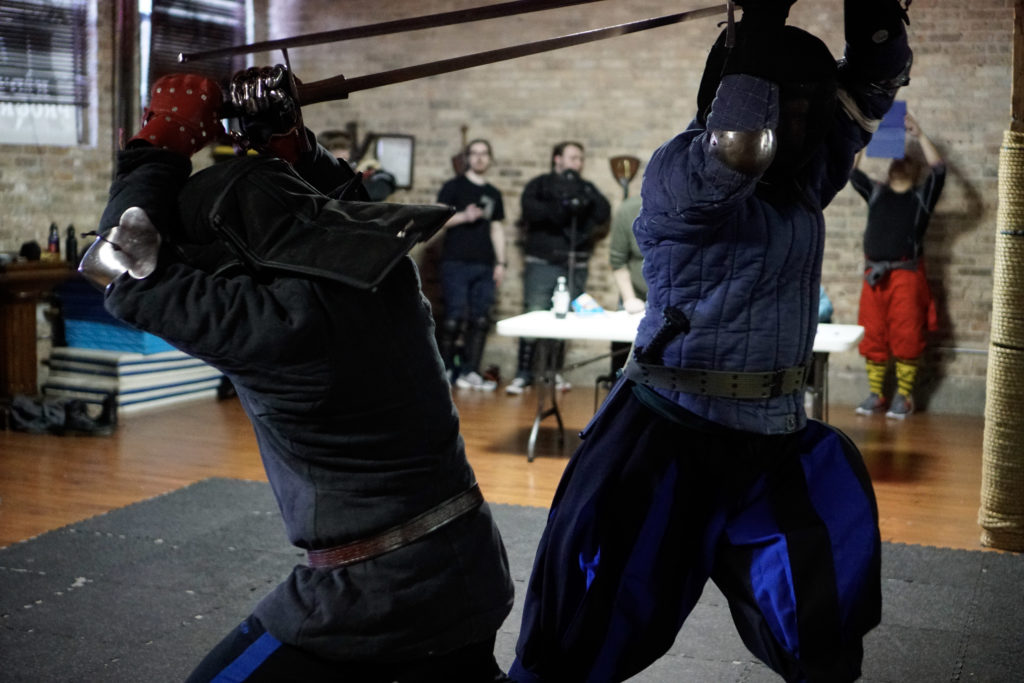
MidWinter Armizare II — This Time with Daggers, our annual contribution to the Midwest Historic Fencing League’s competition circuit is over, and I have to thank everyone involved.
Last year’s event was fun, but a bit chaotic with some snafus. Our principle goals this year were to: 1) streamline the process and 2) Improve judging. I am confident we achieved both of those, although as we all know, improving judging is a perpetual process.
Rationale
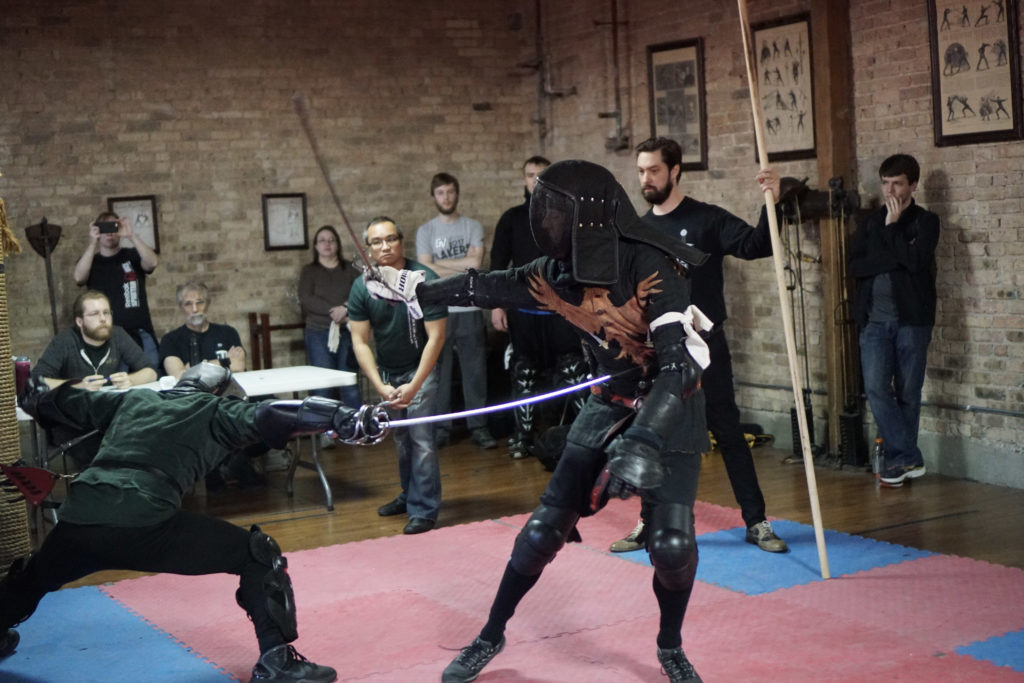
Tournaments are not a big part of what we do at the CSG, far less than many HEMA schools, but I *do* think that developing martial artists need a chance to test themselves against people from outside their school, outside their art. I *don’t* think tournament fighting is any more “real” or reflective of “combat” than any other fencing, in fact some ways less so. (People wear a lot of safety gear and their adrenal reflex is to be more *aggressive*, rather than more *cautious* as you immediately become when faced with sharp weapons.) But it provides a way to learn to manage adrenaline, resist temptation to play the rules, face other styles, and to learn how to use art to defeat “il uomo bestiale” the so-called “untutored fencer” of whom many fencing masters warn.
Put another way, martial artists love to complain about bad sports fighting, and for good reason — combat sports really do often encourage certain gimmicks or actions that are best suited for a ring.
Here’s an example. CSG’s Ben Horwitz fought his first tournament this past weekend, and was able to win his pool fairly easily against some very good combatants. I am SUPER PROUD of him. But although he wins the below fight fairly definitively in score, it wasn’t his best match martially.
Note the move that Ben pulls off at time-stamp 1:55. He manages to duck under Keith’s defense and take a lowline cut. But Keith’s sword is hovering over his head. Sword’s aren’t disintegration rays: unless the man’s arms or head fall off, there is no guarrantee that ANY blow is immediately disabling. Here, the hit scores, and the fight stops. In a real fight, there’s a very good chance that Keith gets his legs slashed and spends time learning to walk with a limp (if infection doesn’t kill him), but first cuts Ben’s head clean off.)
Different groups take these issues into account in different ways. In developing the MidWinter rules (based on those we have used at various events in the past, such as Viva L’Italia and the Western Martial Arts Workshop) I chose to use the following assumptions:
- Real combat is ugly;
- You can’t legislate pretty fencing, but you can design rules the courage good tactics;
- Good tactics will lead to prettier fencing anyway;
- Six hundred years of European fencing masters say the goal is to hit without being hit, so any rule-set should reward never losing a pass, and punish double-hits ruthlessly.
- If the rules take more than one sheet of paper to write out, there are too many of them!
The Rules
Combatants will be divided into pools, fought under the below conditions, with an award to the overall victor.
Tournament One: Single-Handed Sword
Due to the diversity of single-handed sword styles (and scarcity of focused exponents of the same) , this will be a mixed-weapon tournament with the following, permissible weapons:
- Medieval arming-sword;
- Messer;
- Side-sword;
- Rapier (max blade length 45″);
Note: Sabers, backswords, broadswords, smallswords, etc are not permitted. (We love them, too, but we’re keeping this to fencing styles c. 1600 and earlier.)
Tournament Two: Longsword
Longsword’s have a maximum length of 130 cm, minimum weight of 1450 g.
The Winter King
As a culmination of the event, the victors of the two tournaments shall fight a mixed-weapons bout using the previously denoted scoring conventions, with the victor to be declared the winner of the overall tournament
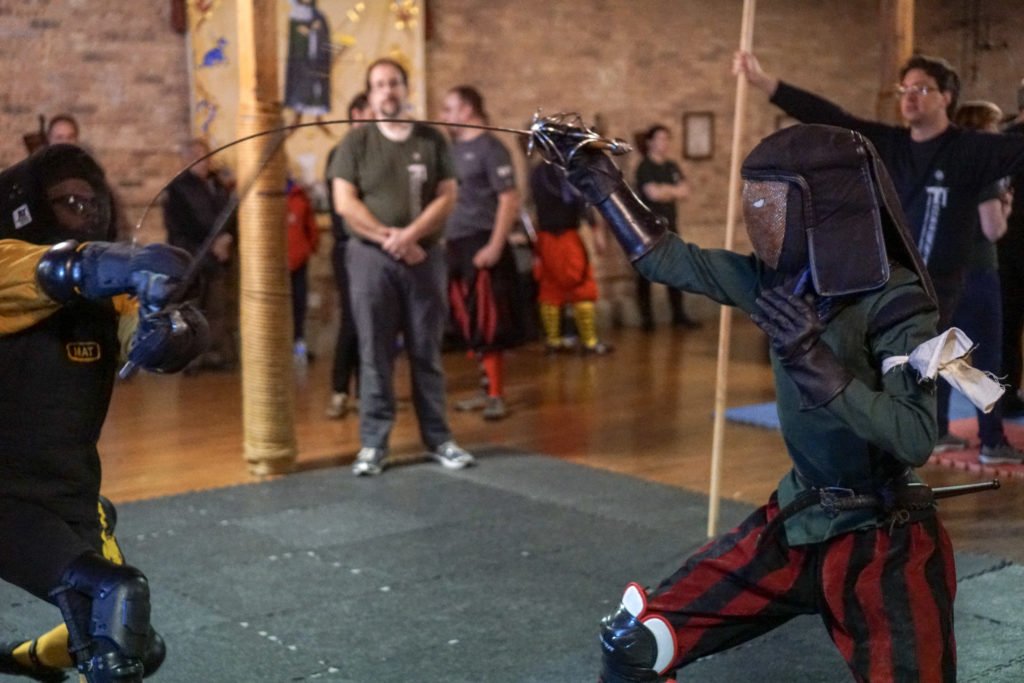
CONVENTIONS OF COMBAT
With the Sword
- Each bout is fought to a total of five landed blows;
- The entire body is a target;
- For our purposes a “blow” constitutes any “fight-ending action”:
- a solid cut with the edge, thrust, disarm or throw;
- a pommel strike to the center of the face;
- a thrust to the center-of-mass with the dagger.
- Incidental blows, light touches, flicks or hits rather than cuts, punches and open-handed strikes that do not end in a throw or lock, etc will not be scored.
With the Dagger
Combatant may carry a dagger on their belt in the longsword tournament, and switch to its use as they see fit.
- Daggers may only strike with the point.
- If a dagger hit is scored, combatants may, after the halt, switch back to their sword.
Grappling
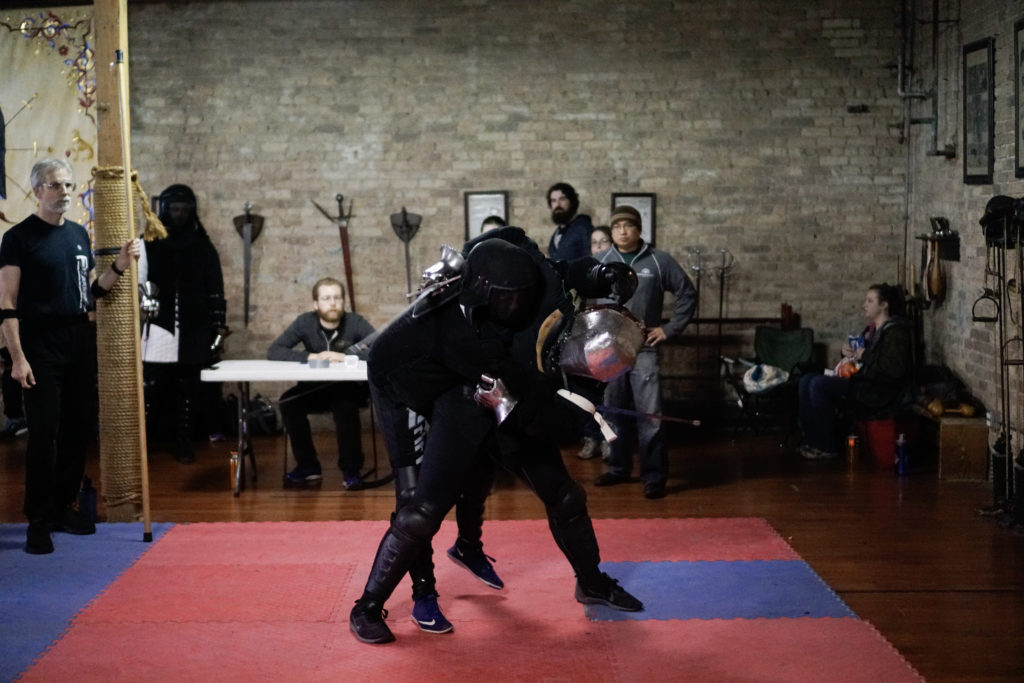
- Grapples that end in a throw with party dominant will score a point.
- Grapples lasting more than 5 seconds or deemed to be dangerous will be halted by the judges;
- Grapples that go to the ground with no one dominant will be halted.
SCORING
Once a fight is concluded, the combatants will report their scores to the list-table. Fights are scored as follows:
- Overall Victor receives 2 pts;
- If the Victor was not struck he or she receives 1 pt additional;
- The person who scored the first blow receives 1 pt;
- If there were any double hits during the match, both parties lose 1 pt.
- Therefore, in any match a combatant could score between 4 and -1 points.
These rules are not meant to be “realistic”, simply to prioritize drawing first blood and avoiding being hit and, most especially double-hits. No matter how many double hits, for the sake of simplicity, only 1 pt is lost. However, additional double hits are not refought, so if you rack up too many double-hits, the victory in that match is going to go with who scored the first blow, and your overall score is going to go down!
ADVANCEMENT
There are two ways to advance to the final round of four combatants – by Score or by Accolade.
Score
After the Pool Round ends, total scores for each will be totaled, and the combatant with the highest score from each pool will move to the finals. (If two or person tie, then the person with the highest total of first blood scores will advance. If there is still a tie, the combatant with the most “never hit” scores will advance.)
Accolade
The list will be “balanced” to an even number by adding a combatant chosen by the other combatants. If the list is already balanced, the Advancement by Acclaim will not be needed. (This wasn’t needed this year)
FINAL ROUND
Once the Finalist are assembled, they shall fight with the prior scoring conventions in a simple single elimination tree. (NB: In the event of a small final list (four or less), the finals may be fought as a pool at the judge’s discretion.
The Results
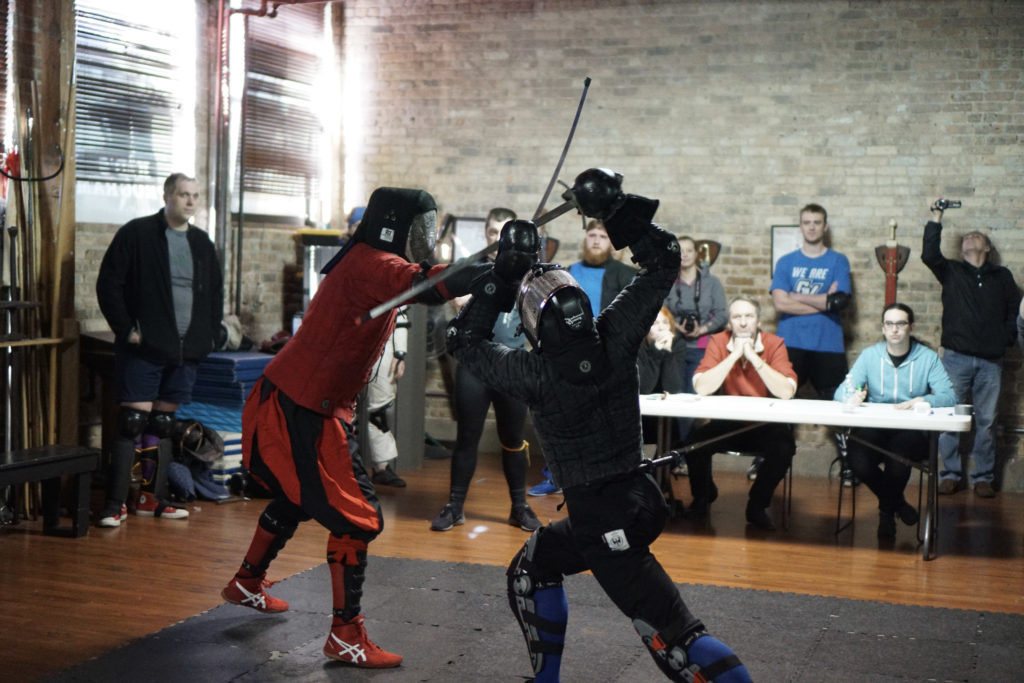
The tournament victors were:
Thomas Niebor — MidWinter King and 1 H Sword
Jesse Kulla — Longsword
Video of the final can be seen here:
https://www.facebook.com/msgellar/videos/10156148388732392/
Although there is no formal prize for second or third place at this event (the guy who comes in #2 in a swordfight is usually called “a corpse” not a silver medalist), the top three competitors in the tournaments were all excellent, and the #2’s could easily have been 1st place. So I would like to congratulate:
Longsword
2nd Place – Adam Franti (with some of the cleanest fencing of the day in both events)
3rd Place – Cameron Metcalf (with the second highest average score of the entire tournament)
One-Handed Sword
2nd Place – Scott Scooter Jeffers (with the HIGHEST average score of the tournament)
3rd Place – Robert Salud
After Sam Street of the Wisconsin Historical Fencing Association pitched a shut-out, winning all three events last year, this year’s tournament was dominated by Guild members and swordsmen from the Michigan diaspora, holding seven of the final eight spots between them in 1H sword and six in longsword. (Sam had to go and mess up the clean sweep!) The pool victors were:
One-Handed Sword Final 8
- Lars Olesen (Minnesota)
- Scott Jeffers (CSG)
- Robbie Salud (CSG)
- Nic Cabrera (CSG)
- Thayne Alexander (CSG)
- Zeke Talmage (Tri-Blade Fencing Academy)
- Sam Brian (??? — I just realized I know Sam, but not where he is from!)
- Thomas Niebor (Michigan)
Longsword Final 8
- Jesse Kulla (CSG)
- Ben Horowitz (CSG)
- Adam Franti (Lansing Longsword Guild)
- Cameron Metcalf (LLG)
- Thayne Alexander (CSG)
- Sam Street (WHFA)
- Thomas Niebor (Michigan)
- Lars Oleson (Minnesota)
Analysis
The fencing on a whole was like all fencing: some amazingly good, some…er….and a lot of bouts that combined moments of brilliance with moments of adrenal reflexes or choking under pressure. That’s how these things go, so let’s focus on the good!
1. Fencers all had a good spirit of friendship and conviviality combined with good sportsmanship. People routinely declined points or called hits when the judges missed something, or if they just felt their hit was ugly or sloppy. This even happened twice in the longsword *finals.* In a perfect world, a judge would never miss anything, but we live in the real world, and I think the one good thing about any errors was that it gave the combatants to show their own character. The following, IMO, shows this in an exemplary fashion:
CSG’s Jesse Kulla and Adam Franti of Lansing Longsword Guild fought a real nice bout for the longsword final. Although their being tired after 6 hrs of fighting meant that there were several double hits, it wasn’t because of stupid choices, it was because of either slowed reflexes, or failing to close a line sufficiently to prevent a counterattack. The best part, however, is that these two gentlemen showed why, IMO, a combatant should always get to call a blow to his own detriment. Our judges blow an early call that would give Jesse the victory. I was pretty sure it was a double hit, but my judges were all in agreement, so I was reticent to second guess them. But Jesse and Adam thought it was a double hit too, and Jesse declined the victory. Next pass, similar issue but reversed roles and before I could make the call, Adam declined the point, and we tried it a third time. Yes, each man gave up his chance to end the fight there and claim victory — those are the character tests competition can give, far more than they test “if you can bring the heat” (whatever the hell that even means in a pretend fight).
(Video courtesy Zeke Talmage)
Here is the fight from a second angle, which also shows what an “adventure” judging can be:
https://www.facebook.com/msgellar/videos/10156148178347392/
2. Although Scott Jeffers and Robert Salud are both CSG members, I think I can say with (minimal) bias that their sidesword bout was one of the most dynamic, prettiest and historically correct of the day. But you be the judge:
(Video Courtesy Zeke Talmage)
3. I always enjoy seeing my friends Adam Franti, Keith Stratten, Josias Arcadia and Zeke Talmage fence. I was super happy to be directing their pools, and in longsword to have almost all of them all in the same pool, with my student Benjamin Horwitz, who did some of his best fencing (after I informed him I had registered him for the tournament, whether he liked it or not). I really enjoyed their pool and the fencing they displayed.
4. Additional kudos to Adam and Keith, who brought proper steel dussacks (Keith’s was barely bigger than a bowie knife) to the 1 H tournament and used them to great affect and with great form, despite knowing they were giving themselves a huge disadvantage against some of the very long, very thin bladed rapiers a few combatants were carrying.
(Video Courtesy Lansing Longsword Guild)
5. Lars Olson was a fantastic in the 1 H sword list, and it was great finding out their is an armizare practitioner, not affiliated with the CSG/Milwaukee in the Midwest.
Of course, as I directed just over a third of the fights, I also missed seeing a bunch of them. I really wanted to see the Sam Street (who won all three events last year), Jesse Kulla rematch, but it was not to be. In fact, I never got to see any of Sam’s fights, and only saw Jesse fight in the finals. Ah well, it’s not about me.
Acknowledgments
Finally, I would like to call out and thank our team:
Kaethe Doherty who wrangled the pools, created the trees and basically did all of the ugly back-end stuff before the event, and then made changes on the fly at the speed of light as we added and dropped people. Their work made the day run far more smoothly than last year. You are a rock-star.
James Reilly, John O’Meara and Rob Rotherfoord directed, and James is functionally my chief lieutenant for the day of the event.
Alex Moe and Joseph Doherty were score-keepers, and were fantastic at it, Alex not least because we drafted him on Saturday morning.
Libby Beyreis, Robine Asamar, Heather Hilchey, Nic James Cabrera, Victor Allen Bayona, Rebecca Smith Cruz, Summer Sparacin, Alexander Shekleton, Andrew Morris, Robert Salud, Ben Horwitz and Jesse Kulla who all judged, a couple of them after being pressed into service.
Alisha Workman, Jess Johnson and Dante Guinazzo who were the event “gophers”. That might not sound like an illustrious job, but GOD it helped having them!
Thanks to Nicole Allen who donated one of her products from SwordGeek Boutique (which launches as an Indiegogo Thursday, but you can get a sneak peak now) as a tournament prize.
Finally, every combatant I didn’t mention — everyone who attends and does so with a good spirit and gives their utmost makes the event.
We’ll do some after action review, continue spending time each CSG FightNight training judges, and hopefully be better in 2019!
